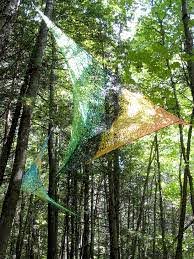Aaron Seay – Humans & Our World

“The Observatory” by Robert Morris (CC BY 2.0)

“Artefact – Bois de Belle Riviere, Quebec” By Edith Meusnier (CC BY-SA 2.0)

“Intolerable Beauty: Portraits of American Mass Consumption” By Chris Jordan (CC BY-SA 2.0)
Preface: My name is Aaron Seay and my portfolio is about interactions between humans and our world exemplified by environmental art. License: CC BY-NC
Introduction: Today we will be analyzing work by Robert Morris, Edith Meusnier, and Chris Jordan. The art by Robert Morris is a work that exemplifies humanities affect on earth with history. Edith Meusnier is a textile artist that utilizes vibrant colors within natural earthly spaces. Chris Jordan’s work exposes human pollution in our world.
Themes: Within the art I’ve selected we can see a theme of the long term effects that humans leave on our environment. This can be seen with how the architecture from a war that took place years ago is still standing and could forever be a sign of the times. This also can be seen with the massive accumulation of cellular devices over years that were found in industrial yards compacted within a confined frame of view. Another theme that we are exploring is the contrast created from colors in our natural world and human made color. When we see the two opposing aesthetics come together it makes for a truly appealing combination.
Analysis: I have three images to display human interactions with our world. The first image captures “The Observatory”. This is a historic work created by multiple purposes. Robert Morris designed “The Observatory” in fears of nuclear war which was prevalent in the 20th century. It was as well used for observing open air exhibition in the Netherlands. This art does a great job in sculpting the environment to be visually appealing along with purpose for usage. My next image is “Intolerable Beauty: Portraits of American Mass Consumption”. The devices in the image are gathered within the years 2003-2005 in America alone. This image visualizes just how much plastic and metal we polluted our world with within the early half of the 21st century. Viewing this image is purely shocking and should serve as an eye opener to all. My final image is titled “Artefact – Bois de Belle Riviere, Quebec”. Edith Meusnier is notorious for bright textile art oddly placed in our natural environment. Edith produced her works inspired by 20th century artists like Walter Gropius and Paul Klee. The effect of her vibrant inorganically colored textile contrasting with the organic natural colors in our world exemplifies how humans interacting with the environment can create a visually pleasing work of art.
Application: From researching the art I’ve selected we can quite literally see how earth and humanity mesh and clash together. As we can create beautiful things in our environment like Edith Meusnier and Robert Morris, we can as well pollute and destroy it through mass consumption leading to awful effects like climate change and global warming. Our history will be seen for years to come so I hope that the art I have provided can encourage all to leave behind a pleasant imprint on our world.

